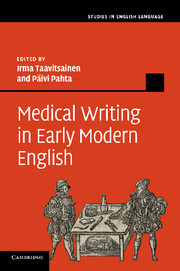Book contents
- Frontmatter
- Contents
- List of plates
- List of figures
- List of tables
- Notes on contributors
- Preface
- List of abbreviations
- 1 An interdisciplinary approach to medical writing in Early Modern English
- 2 Medical texts in 1500–1700 and the corpus of Early Modern English Medical Texts
- 3 Medical literacies and medical culture in early modern England
- 4 Verbs of knowing: discursive practices in early modern vernacular medicine
- 5 Defining in Early Modern English medical texts
- 6 Dissemination and appropriation of medical knowledge: humoral theory in Early Modern English medical writing and lay texts
- 7 Code-switching in Early Modern English medical writing
- 8 New arguments for new audiences: a corpus-based analysis of interpersonal strategies in Early Modern English medical recipes
- 9 Efficacy phrases in Early Modern English medical recipes
- 10 Medical pamphlets: controversy and advertising
- 11 The development of specialized discourse in the Philosophical Transactions
- 12 The expression of stance in early (1665–1712) publications of the Philosophical Transactions and other contemporary medical prose: innovations in a pioneering discourse
- Appendix A Raw data tables corresponding to Figures 4.3–4.14
- Appendix B Raw data tables corresponding to Figures 8.1–8.4
- Appendix C Stance markers used in the analysis in Chapter 12
- Appendix D Preliminary list of texts in the corpus of Early Modern English Medical Texts (EMEMT)
- Bibliography
- Index
1 - An interdisciplinary approach to medical writing in Early Modern English
Published online by Cambridge University Press: 03 May 2011
- Frontmatter
- Contents
- List of plates
- List of figures
- List of tables
- Notes on contributors
- Preface
- List of abbreviations
- 1 An interdisciplinary approach to medical writing in Early Modern English
- 2 Medical texts in 1500–1700 and the corpus of Early Modern English Medical Texts
- 3 Medical literacies and medical culture in early modern England
- 4 Verbs of knowing: discursive practices in early modern vernacular medicine
- 5 Defining in Early Modern English medical texts
- 6 Dissemination and appropriation of medical knowledge: humoral theory in Early Modern English medical writing and lay texts
- 7 Code-switching in Early Modern English medical writing
- 8 New arguments for new audiences: a corpus-based analysis of interpersonal strategies in Early Modern English medical recipes
- 9 Efficacy phrases in Early Modern English medical recipes
- 10 Medical pamphlets: controversy and advertising
- 11 The development of specialized discourse in the Philosophical Transactions
- 12 The expression of stance in early (1665–1712) publications of the Philosophical Transactions and other contemporary medical prose: innovations in a pioneering discourse
- Appendix A Raw data tables corresponding to Figures 4.3–4.14
- Appendix B Raw data tables corresponding to Figures 8.1–8.4
- Appendix C Stance markers used in the analysis in Chapter 12
- Appendix D Preliminary list of texts in the corpus of Early Modern English Medical Texts (EMEMT)
- Bibliography
- Index
Summary
Historically, language is an indispensable guide both to theoretical scientific ideas and to real actions. Any language embodies a theory of meaning, a logic, a classification of experience, a conception of perceiver, knower and agent and their objects, and an apprehension of existence in space and time. We need to ask how language conditioned scientific thinking and was in turn altered by it. We may distinguish three levels: those of the structure of a language itself, of general conceptions of the nature of things expressed in it, and of particular theories.
(Crombie 1995: 232–3)This book examines the connection of language and science in English medical writings in the period 1500–1700. We approach this link through situated analyses of language and texts, paying attention to context in all its multifaceted aspects, from the broad context of culture to situational and cognitive discourse contexts and to the narrow linguistic context. The twelve chapters of the book analyse language use in medical texts in their disciplinary, social and societal embedding. The basic theoretical assumption on which the book relies is the view of language as communication that always takes place in a particular context of discourse, characterized by time and place, between people – speakers and hearers or writers and readers – and for a particular purpose. This communicative situation has an impact on how the speakers or writers formulate their message.
- Type
- Chapter
- Information
- Medical Writing in Early Modern English , pp. 1 - 8Publisher: Cambridge University PressPrint publication year: 2011
- 2
- Cited by



